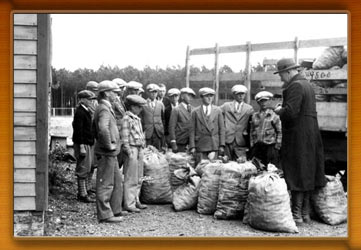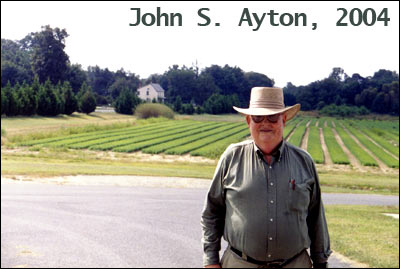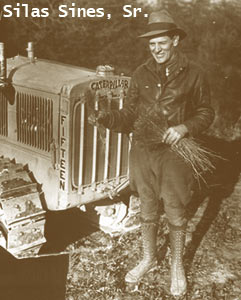By Francis “Champ” Zumbrun
"The best time to plant a tree was twenty years ago - the second best time is
today."
- Anonymous
In 1914, the Maryland Legislature passed the Roadside Tree Law. It was one of the
first laws in the country that gave a state forestry department authority to
plant, care for, and protect trees in the public right of way. It also enabled the
State Board of Forestry to establish a state tree nursery, with a primary
purpose of growing trees for roadside planting.
In 1914, Maryland’s first state forest tree nursery was established at
College Park. The University of Maryland, originally the Maryland Agricultural
College, donated this tract of land, located at Paint Branch and the
intersection of Route 1 and Lakeland Road.
The nursery later evolved and expanded to grow seedlings for conservation
purposes including wildlife habitat, watershed and soil protection, and forest
products. The state tree nursery was important to the ecological restoration of
Maryland’s forested landscape that was devastated from abusive logging and
agricultural practices that occurred in the late 19th century.
 Fred W. Besley,
a student of Gifford Pinchot (father of American forestry),
brought forest tree nursery science to Maryland as its first state forester.
Besley gained his knowledge and experience from working in 1904 as a
superintendent at the U.S. Forest Service Tree Nursery at Halsey, Nebraska, the
first federal tree nursery established in the country.
Fred W. Besley,
a student of Gifford Pinchot (father of American forestry),
brought forest tree nursery science to Maryland as its first state forester.
Besley gained his knowledge and experience from working in 1904 as a
superintendent at the U.S. Forest Service Tree Nursery at Halsey, Nebraska, the
first federal tree nursery established in the country.
Kirk Rodgers, Fred W. Besley’s grandson, said that one of the earliest and
most vigorous efforts his grandfather undertook as a state forester was to
establish a state tree nursery. “He was particularly interested in forest
regeneration. He was ashamed with the way Maryland’s roadsides looked. He made
this into a crusade."
During his term as State Forester between the years 1906-1942, Besley
established three state forest tree nurseries, all on the property or near the
University of Maryland at College Park. With each passing year, productivity
increased at the tree nursery from thousands to millions of of trees produced annually.
Around 1944, the State expanded operations to the Beltsville Experimental
Tree Nursery. From 1949 to 1950, the tree nursery at College Park closed and
moved to Harmons, in Anne Arundel County. Here, a new Tree Improvement Program
propagated superior Loblolly and Eastern White Pine. Harmons was the first state
tree nursery to sit on land actually owned and deeded to the Maryland Forest
Service. Later it was renamed Buckingham Tree Nursery, after the third State
Forester who had a strong interest and background in the tree nursery science.
 In 1996, due to the construction of Route 100, the Nursery relocated again to its present site near Preston, in Caroline County on the eastern shore; it was renamed John S. Ayton Forest Tree Nursery, for the person most instrumental in its establishment.
In 1996, due to the construction of Route 100, the Nursery relocated again to its present site near Preston, in Caroline County on the eastern shore; it was renamed John S. Ayton Forest Tree Nursery, for the person most instrumental in its establishment.
Since 1914 to the present, only a handful of individuals have served as head
nurseryman at the state tree nursery, among them was Silas Sines, a native of
Garrett County. From 1929-1974, Sines oversaw and guided the growth and
operations of the state forest tree nursery.
Over time, the self-sufficient work habits of Sines have become legend. Sines
pioneered methods for economically growing and replanting large numbers of
healthy trees. The employees he supervised respected and looked up to him. He
was not above working in the field right along with his staff.
 Sines was sought out by professional nurserymen and foresters for his insight and knowledge about growing and transplanting trees. They were amazed at Sines’ creative innovations, made even the more remarkable as Sines had very little formal education. They traveled long distances to study Sines’ practices, and photograph tools and equipment he designed such as the root-pruner, tree planter, and pine cone seed extractor.
Sines was sought out by professional nurserymen and foresters for his insight and knowledge about growing and transplanting trees. They were amazed at Sines’ creative innovations, made even the more remarkable as Sines had very little formal education. They traveled long distances to study Sines’ practices, and photograph tools and equipment he designed such as the root-pruner, tree planter, and pine cone seed extractor.
Because of Sines, the Maryland State Forest Tree Nursery gained a reputation
among nurserymen in the eastern United States for growing the best tree
seedlings at the cheapest price. Henry C. Buckingham, the third state forester,
once told a group of nurserymen that of all the trees grown at tree nurseries in
the eastern United States, Maryland's trees stood out like a "fly in
buttermilk."
Perhaps this quote from Larry Maxim, Savage River State Forester, best
captures the significance of Maryland’s State Forest Tree Nursery: “The State
Forest Tree Nursery symbolizes man’s hope for the future. It is a testimony to
man’s love for the forest and his desire to establish trees where there are
none. People who work at a nursery are doing God’s work. Tree nurseries are the
epitome of what forestry is all about – reestablishing and maintaining the
health of the forest.”
Silas Sines, a native of Garrett County, oversaw and guided the growth
and operations of the state forest tree nursery from 1929-1974.
John S. Ayton, former nursery supervisor at the Buckingham State
Forest Tree Nursery, was instrumental in the design and construction, from
buildings to grounds and operations, of the present-day nursery which bears his
name. John began his career with DNR’s Forest Service in 1961 and retired
in 1996, one year after the John S. Ayton State Forest Tree Nursery was
completed.
Richard Garrett became the John S. Ayton State Tree Nursery Manager in
1996. Richard has been with the DNR Forest Service since 1984.